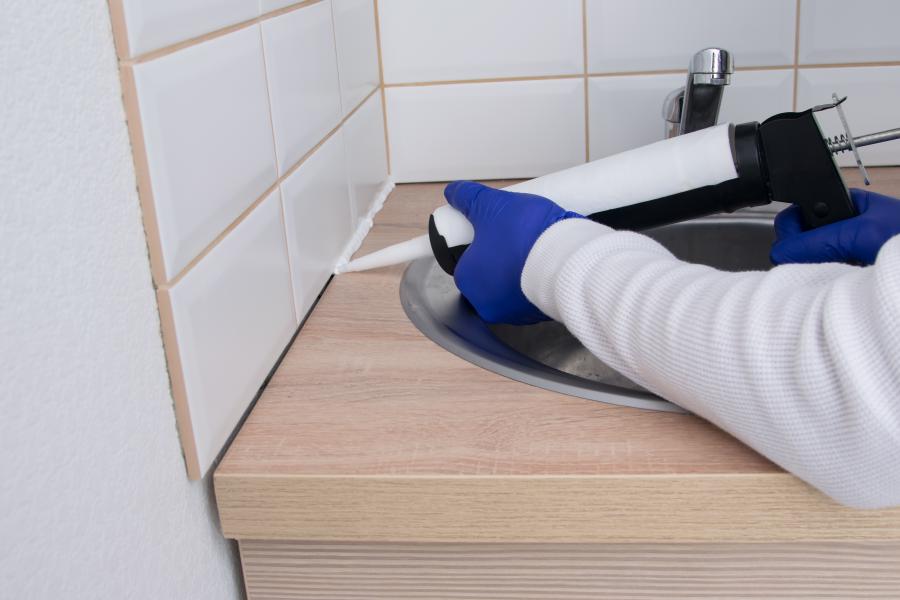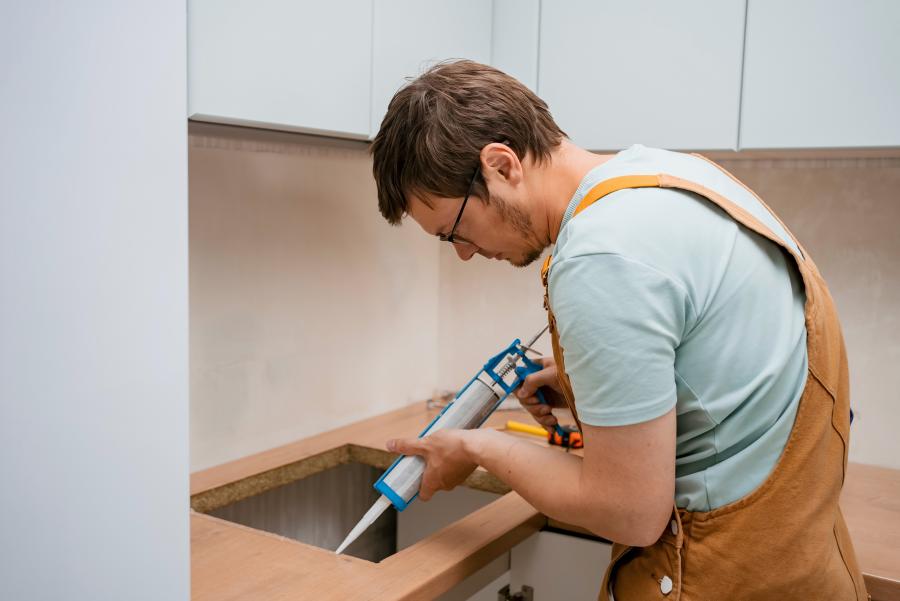Expert guidance from BoPin Construction Chemicals – ending the confusion once and for all
The Most Common Question in the Caulk Aisle, Answered
You’re standing in front of a wall of sealant tubes. Some say “Acrylic Latex.” Others say “100% Silicone.” They look similar. The prices are comparable. But choosing the wrong one can lead to cracked paint, moldy showers, and failed seals.
What’s the real difference, and how do you choose?
Here’s what makes this confusing: Both products seal gaps. Both come in similar tubes. Both require a caulk gun. But they’re engineered for completely different jobs, and using one where you should use the other is one of the most common DIY mistakes.
This guide will end the confusion. We’ll break down the pros and cons of each in simple terms. And we’ll give you a clear, definitive answer on which product to use for every project in your home.
The result? Confidence that you’re using the right product, and seals that last for years instead of failing within months.
The Main Event: The Ultimate Comparison Table
Here’s the quick answer for those who just need to know which tube to grab:
| Feature | Acrylic Latex Caulk<br>(The Painter’s Friend) | 100% Silicone Sealant<br>(The Waterproof Champion) |
|---|---|---|
| Primary Advantage | Paintable | Waterproof & Flexible |
| Best For… | Interior trim, baseboards, filling drywall cracks | Showers, tubs, sinks, windows, exteriors |
| Cleanup | Easy (Water) | Difficult (Solvent) |
| Flexibility | Good (±7.5-12.5%) | Excellent (±25-50%) |
| Durability | Good (in dry areas) | Excellent (20+ years) |
| Su Yalıtımı | Water-resistant only | Truly waterproof |
| Odor | Low/None | Can have strong vinegar odor |
| Shrinkage | Minimal (<15%) | Virtually none |
| Price | Lower ($3-6/tube) | Moderate ($5-10/tube) |
Still not sure? Read on for detailed explanations and specific use cases.
When to ALWAYS Use Acrylic Latex Caulk
If you need to paint it, you need acrylic caulk. This is the golden rule that solves 90% of the confusion.
The Core Advantage: Paintability
Acrylic latex caulk accepts paint beautifully because it has a slightly porous surface that paint can grip. 100% silicone, on the other hand, is completely non-porous – paint simply beads up and peels off.
Think of it this way: Acrylic is like paper that absorbs ink. Silicone is like plastic wrap that repels everything.
Perfect Use Cases for Acrylic Caulk
✓ Sealing gaps between baseboards/trim and walls
This is the #1 application for acrylic caulk. You’ll paint over these joints to create a seamless, professional look. Using silicone here would leave ugly unpainted lines that scream “amateur.”
✓ Filling cracks in drywall before painting
Acrylic caulk is perfect for filling hairline cracks and small gaps in walls and ceilings that will be painted. It blends invisibly when painted.
✓ Around interior door and window trim
Where trim meets the wall in dry interior spaces, acrylic caulk creates clean lines that disappear under paint.
✓ Crown molding and architectural details
Anywhere you need a seamless, paintable finish in areas that won’t get wet, acrylic caulk is your friend.
✓ Wall and ceiling joints
In dry interior spaces, acrylic caulk fills gaps while maintaining the ability to be painted for a uniform finish.
Why Acrylic Works Here
The formulation is designed for paintability and ease of use:
- Water-based – cleans up with water before curing
- Low odor – safe for occupied spaces
- Fast paint-ready time – often 30 minutes to 4 hours
- Good adhesion to porous surfaces like wood and drywall
- Economical for large trim projects
When to ALWAYS Use 100% Silicone Sealant
If it’s going to get wet, you need 100% silicone. This is the second golden rule.
The Core Advantage: Waterproof Performance
100% silicone creates a truly waterproof seal that can withstand continuous water exposure, pressure, and moisture indefinitely. Acrylic caulk is only water-resistant – it will break down with prolonged water exposure.
Think of it this way: Silicone is a wetsuit. Acrylic is a windbreaker that might keep off light rain.
Perfect Use Cases for 100% Silicone
✓ Sealing around showers and bathtubs
This is where silicone absolutely dominates. BoPin 550 Sanitary Silicone provides waterproof protection with advanced anti-mold technology that keeps shower seals clean and healthy for 15-20 years.
✓ Kitchen and bathroom sinks
Where water pools and splashes regularly, only 100% silicone provides reliable long-term waterproofing.
✓ Exterior windows and doors
Weather sealing requires silicone’s combination of waterproofing and extreme flexibility to handle temperature changes and building movement.
✓ Exterior siding and trim joints
UV exposure, rain, snow, and temperature extremes demand silicone’s superior durability and weather resistance.
✓ Any high-moisture environment
Laundry rooms, mudrooms, basements – anywhere moisture is present regularly needs silicone’s waterproof properties.
Why Silicone Works Here
The chemistry is engineered for extreme performance:
- Permanently waterproof – will never break down from water exposure
- Extreme flexibility – handles ±25-50% joint movement
- Superior adhesion to non-porous surfaces (glass, ceramic, metal)
- Mold and mildew resistant – especially formulated bathroom versions
- Temperature resistant – maintains properties from -40°C to +120°C
- UV stable – won’t degrade in direct sunlight
The “In-Betweener”: What is “Siliconized” Acrylic Caulk?
This common term causes significant confusion. Let’s clear it up.
What It Actually Is
Siliconized acrylic is an acrylic latex caulk with a small amount of silicone added (typically 2-10%) to improve its flexibility and adhesion.
Think of it as acrylic caulk’s more athletic cousin – still fundamentally acrylic, but with enhanced performance.
What It’s Good For
Siliconized acrylic is an upgrade over basic painter’s caulk:
- Better flexibility than pure acrylic (typically ±12.5% vs ±7.5%)
- Improved adhesion to slightly difficult surfaces
- Still paintable like regular acrylic
- Enhanced durability in moderate-moisture areas
BoPin A-630 Premium Paintable Acrylic uses advanced siliconized acrylic technology for superior performance while maintaining excellent paintability.
What It’s NOT
Siliconized acrylic is NOT a substitute for 100% silicone in wet areas. The small amount of silicone added doesn’t make it waterproof.
Don’t use it for:
- Shower and bathtub sealing
- Continuous water exposure
- Exterior applications requiring maximum weather resistance
It’s a better acrylic, not a type of silicone.
Our Professional Recommendations
Use the right product for the right job – here are our top-rated solutions for each application.
For a Flawless, Paintable Finish: BoPin A-630 Premium Paintable Acrylic
BoPin A-630 Premium Paintable Acrylic Sealant delivers professional results for all your interior finishing projects.
Why It’s the Painter’s Choice:
Superior Paintability: Minimal cracking even with low-elasticity paints. The advanced siliconized formula accepts paint as well as the surrounding wall or trim.
Enhanced Flexibility (±12.5%): Significantly outperforms standard acrylics, accommodating normal building movement without paint cracking.
Fast Paint-Ready Time: Apply paint in as little as 2-4 hours under normal conditions, speeding up your project completion.
Excellent Adhesion: Strong bonding to wood, drywall, plaster, and concrete without primer in most applications.
Low VOC (<30 g/L): Environmentally friendly with minimal odor – safe for occupied spaces.
Minimal Shrinkage (<15%): Maintains joint fill without gaps or cracks forming during cure.
For a Permanent, Waterproof Seal: BoPin 550 Sanitary Silicone
BoPin 550 Sıhhi Nötr Silikon Mastik provides lifetime waterproof protection for your home’s toughest jobs.
Why It’s the Waterproof Champion:
Advanced Anti-Mold Technology: Superior resistance to mold and fungus growth keeps bathroom and kitchen seals clean and healthy for 15-20 years.
Rapid Waterproofing: Creates effective water barrier within 30 minutes of application – full waterproof performance in 24 hours.
Chemical Resistance: Withstands household cleaners, bleach, and disinfectants without degradation or discoloration.
Stone-Safe Formula: Can be used on natural stone without causing staining or discoloration – certified non-staining.
Exceptional Flexibility (±25%): Maintains waterproof seal despite building movement, temperature changes, and vibration.
MEKO-Free & Low VOC (<35 g/L): Environmentally safer formulation without compromising performance.
Acrylic vs. Silicone FAQ
What happens if I paint over silicone?
The paint will fail catastrophically. Paint cannot chemically bond to silicone’s ultra-smooth, non-porous surface.
What you’ll see:
- Paint beads up during application (like water on wax)
- Fish-eyes and bare spots
- Paint peels away in sheets within days
- Exposed silicone that’s impossible to cover
If you’ve accidentally used silicone where you need paintability, you must remove it completely and start over with acrylic caulk.
Is acrylic latex caulk waterproof?
No, acrylic latex caulk is water-resistant, not waterproof. This distinction is critical.
Water-resistant means:
- Can handle occasional splashes
- Resists light moisture and humidity
- Fine for interior dry areas
But it will fail with:
- Continuous water exposure (showers, tubs)
- Standing water or pooling
- Exterior weather exposure
- High-moisture environments
For true waterproofing, always use 100% silicone sealant.
Which one is easier to use for beginners?
Acrylic caulk is significantly easier for beginners for several reasons:
Easy cleanup: Mistakes wipe away with water before the caulk cures. With silicone, you need solvents and it’s messy.
Forgiving application: You can smooth and re-tool acrylic multiple times. Silicone skins over quickly and becomes difficult to work with.
Less odor: Acrylic has minimal smell. Some silicones (acetoxy-cure) produce strong vinegar odors.
Paintable: If you mess up the color match or bead appearance, you can just paint over acrylic.
However, silicone isn’t difficult if you work within its limitations – just less forgiving of mistakes.
Can I use silicone for everything to avoid confusion?
No, this creates different problems:
You can’t paint silicone – so all your trim work will have visible unpainted caulk lines.
Silicone costs more – using it everywhere wastes money on applications where cheaper acrylic works fine.
Silicone cleanup is messy – you’ll hate yourself when doing large trim projects with solvent cleanup.
Better approach: Learn the simple rules (paintable = acrylic, wet = silicone) and use the right tool for each job.
How long does each type last?
100% Silicone Sealant: 15-25+ years when properly applied and maintained. Premium bathroom silicones can easily last 20+ years.
Acrylic Latex Caulk: 5-15 years in appropriate dry interior applications. Quality products at the higher end, economy products at the lower end.
The longevity difference reflects their different purposes – silicone is engineered for extreme durability, while acrylic prioritizes paintability and ease of use.
Choose the Right Tool, Get the Right Result
The decision between acrylic and silicone really is this simple:
For painting → Use Acrylic For water → Use Silicone
These two golden rules solve 95% of application decisions. The remaining 5% falls into specialized categories where you might need hybrid products or specific formulations, but for typical home projects, this simple framework works perfectly.
The cost of using the wrong product goes far beyond the price of the tube:
- Time wasted removing failed caulk
- Material costs to redo the work
- Potential water damage from inadequate waterproofing
- Ugly appearance from unpaintable silicone in visible areas
Professional contractors and experienced DIYers follow these rules religiously because they’ve learned from experience that shortcuts and substitutions always fail eventually.
Invest a few minutes learning which product to use, and you’ll save hours of frustration and rework later.
Stop guessing and get the right product for your project. Explore our complete line of professional-grade acrylic and silicone sealants designed for reliable, long-lasting results.
Need help choosing the right sealant for your specific project? BoPin Construction Chemicals provides professional-grade products and expert technical support for every application.



